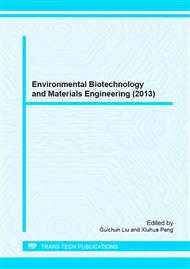[1]
S. L. Lu, L.Y. Shao, M. H. Wu. Mineralogical characterization of airborne individual particulates in Beijing PM10. Environmental Science Journal. 2006, 18(1): 90-95.
Google Scholar
[2]
J. H. Tan, J. C. Duan, J. P. Zhao, et al. The size distribution of organic carbon and element carbon during haze period in Guangzhou. Environmental Chemistry. 2009, 28(2): 267-270.
Google Scholar
[3]
Y. Sun, G. Zhuang, A. Tang, et al. Chemical characteristics of PM2. 5 and PM10 in haze-fog episodes in Beijing. Environmental Science and Technology. 2006, 40: 3148-3155.
DOI: 10.1021/es051533g
Google Scholar
[4]
H. K. Yang, F. Ma, Y. Zhang, et al. The characteristics of PM2. 5 in Beijing, China. Atmospheric Environment. 2001, 35: 4959-4970.
Google Scholar
[5]
X. Yao, C. K. Chan, M. C. Fang, et al. The water-soluble ionic composition of PM2. 5 in Shanghai and Beijing, China. Atmospheric Environment. 2002, 36: 4223-4234.
DOI: 10.1016/s1352-2310(02)00342-4
Google Scholar
[6]
W. Ying, G. S. Zhuang, Y. L. Sun, et al. The variation of characteristics and formation mechanisms of aerosols in dust, haze, and clear days in Beijing. Atmospheric Environment. 2006, 40: 6579-6591.
DOI: 10.1016/j.atmosenv.2006.05.066
Google Scholar
[7]
C. S. Yuan, C. C. Sau, M. C. Chen. Influence of Asian dusts on the physicochemical properties of atmospheric aerosols in Taiwan district - using the Penghu Islands as an example. Particuology. 2004, 2(4): 144-152.
DOI: 10.1016/s1672-2515(07)60045-1
Google Scholar
[8]
C. K. Man, M. Y. Shih. Identification of sources of PM10 aerosols in Hong Kong by wind trajectory analysis. Aerosol Science. 2001, 32: 1213-1223.
DOI: 10.1016/s0021-8502(01)00052-0
Google Scholar
[9]
H. A. Gray, G. R. Cass. Characteristics of atmospheric organic and elemental carbon particle concentrations in Los Angeles. Environ. Sci. Technol. 1986, 20: 580-589.
DOI: 10.1021/es00148a006
Google Scholar
[10]
S. L. Lu, L.Y. Shao, M. H. Wu. Mineralogical characterization of airborne individual particulates in Beijing PM10. Environmental Science Journal. 2006, 18(1): 90-95.
Google Scholar
[11]
J. H. Tan, J. C. Duan, J. P. Zhao, et al. The size distribution of organic carbon and element carbon during haze period in Guangzhou. Environmental Chemistry. 2009, 28(2): 267-270.
Google Scholar
[12]
Y. Sun, G. Zhuang, A. Tang, et al. Chemical characteristics of PM2. 5 and PM10 in haze-fog episodes in Beijing. Environmental Science and Technology. 2006, 40: 3148-3155.
DOI: 10.1021/es051533g
Google Scholar
[13]
W. Ying, G. S. Zhuang, Y. L. Sun, et al. The variation of characteristics and formation mechanisms of aerosols in dust, haze, and clear days in Beijing. Atmospheric Environment. 2006, 40: 6579-6591.
DOI: 10.1016/j.atmosenv.2006.05.066
Google Scholar
[14]
C. S. Yuan, C. C. Sau, M. C. Chen. Influence of Asian dusts on the physicochemical properties of atmospheric aerosols in Taiwan district - using the Penghu Islands as an example. Particuology. 2004, 2(4): 144-152.
DOI: 10.1016/s1672-2515(07)60045-1
Google Scholar


